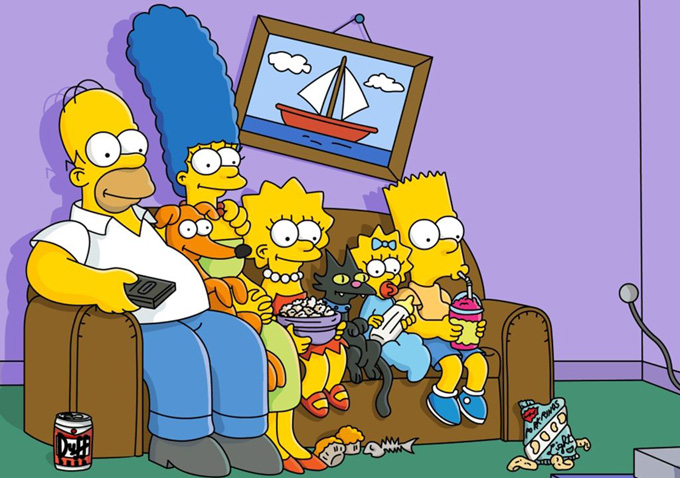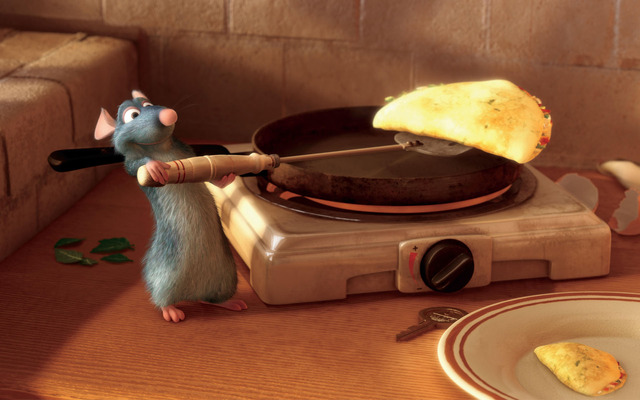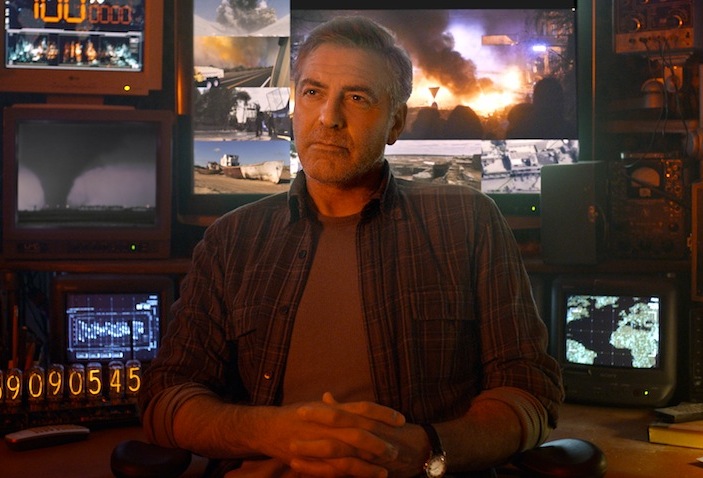By providing your information, you agree to our Terms of Use and our Privacy Policy. We use vendors that may also process your information to help provide our services. This site is protected by reCAPTCHA Enterprise and the Google Privacy Policy and Terms of Service apply.
Tribeca: Brad Bird on Learning From ‘The Simpsons’ and What Inspired ‘Tomorrowland’

READ MORE: Brad Bird Confirms He’s Now Writing ‘The Incredibles 2’
Bird got his foot in the door at Disney at age 11.
“I had seen ‘Jungle Book’ and was psyched by it. It occurred to me that somebody actually made a living figuring out how a stuffy panther moved. I always thought as a kid, adults were kind of boring and I thought, ‘Oh god I’m going to grow up to be that.’ But, I realized there were all of these cool jobs. When I realized that somebody made this cartoons, that it didn’t just happen, it seemed like, wow, the adult world is very exciting. So I just tried to find anyone that I knew of at Disney. My parents friends went to school with a composer for the Disney films, so I met him when he was up in Oregon. He said, ‘Next time you’re in L.A. I’ll take you through the studio.’ He took me through at 11 and I met all the top people in the animation department and I actually knew who they were at that point because there was one book that I read to death about the art of animation. I remember meeting Frank [Thomas] and Ollie [Johnston], two of Disney’s ‘Nine Old Men.’ They kinda gave me this look that was very nice but kinda like, ‘You’re gonna lose interest in two weeks kid. We’ll never see you again.’ So they were kinda shocked three years later when I showed up with a 15 minute film. They responded to it and that’s when they started mentoring me.”
He learned a lot from “The Simpsons.”
 “I worked on eight seasons of ‘The Simpsons’ as a consultant, I was there probably two days out of every week, sometimes three. It’s kind of like that thing of ‘I Love Lucy’ when she has the chocolates, and she keeps shoving more chocolates down because she can’t keep up with them. If you slow down in television, you will get eaten alive. I learned a hell of a lot from being on ‘The Simpsons’ because I saw episodes that were deeply in trouble up to two weeks before they were going to air. These are things that take six months to go through the whole process, from the beginning of the writing to the end of shooting and color. They would be almost done and things wouldn’t work, and somebody would make a genius move of reediting something or re-voicing one part, and suddenly it would work beautifully.
“I worked on eight seasons of ‘The Simpsons’ as a consultant, I was there probably two days out of every week, sometimes three. It’s kind of like that thing of ‘I Love Lucy’ when she has the chocolates, and she keeps shoving more chocolates down because she can’t keep up with them. If you slow down in television, you will get eaten alive. I learned a hell of a lot from being on ‘The Simpsons’ because I saw episodes that were deeply in trouble up to two weeks before they were going to air. These are things that take six months to go through the whole process, from the beginning of the writing to the end of shooting and color. They would be almost done and things wouldn’t work, and somebody would make a genius move of reediting something or re-voicing one part, and suddenly it would work beautifully.
“It was like storytelling camp, because ‘The Simpsons’ scripts, as googly eyed as everybody is and crazy looking, the scripts are actually very sophisticated and would have an A story and a B story and sometimes a C story and keep things popping. In 22 minutes they would do like 40 minutes worth of material, so I learned a lot from being on that. Television forces you to make decisions quickly and that has served me very well in film. With ‘Iron Giant,’ we had a limited budget and a shortened schedule compared to Dreamworks or Disney films. With ‘The Incredibles,’ we had this great studio and a big budget and support, but we wanted to make a film that was three times bigger than anything they had done without it costing any more money. So all the TV stuff really was handy because you cannot linger over a decision, you have to just make it and move on in TV, and that has been great for me in movies.”
Animators have to break computers’ instincts.
“Some people don’t appreciate that [computer animation] is an art form. They think that there’s a button that’s like ‘Make Movie’ and that it just gets done. The computers want to do everything exactly and cleanly and evenly, not organically. If you wanna do that they can do it no problem. But if you want them to present anything that approximates the natural world, they will fight you any step of the way. Less so now. But all of those flaws that you see on ‘Ratatouille’ on the kitchen floor, each one of those tiles is on a slightly different level. Somebody had to do that because the computer wants to do that exact; everything perfect in its place. If you want imperfections you have to tell the computer, I don’t want them to match, I want them to be asymmetrical. And that was done because, through research, when you have actual tiles that have been around in a kitchen that long, they’re different, so light hits them differently.”
READ MORE: 13 Indie Directors Who Should Take On Disney Live-Action Remakes
Voice acting is just as hard as regular acting.
 “You’re limited by how interested people are in being on your project. Peter O’Toole for example said, ‘Oh I don’t know I don’t really do animation.’ So I had to kind of woo him a little bit. I said, ‘No you’re going to love it. It’s a weird part. He really dominates the film when he’s in it. I think you’d have fun.’ He kind of came around to it and he ended up having a great time. I think some people think it’s going to be super easy, like come in and bang out a few lines, you don’t have marks to hit, you can have a bad night and nobody’s going to know, unless your voice is ragged. They think it’s going to be easy. It’s not easy, it’s hard.
“You’re limited by how interested people are in being on your project. Peter O’Toole for example said, ‘Oh I don’t know I don’t really do animation.’ So I had to kind of woo him a little bit. I said, ‘No you’re going to love it. It’s a weird part. He really dominates the film when he’s in it. I think you’d have fun.’ He kind of came around to it and he ended up having a great time. I think some people think it’s going to be super easy, like come in and bang out a few lines, you don’t have marks to hit, you can have a bad night and nobody’s going to know, unless your voice is ragged. They think it’s going to be easy. It’s not easy, it’s hard.
“Part of what makes it hard is, your job in some way is to inspire an animator. What takes an actor five seconds to say might take an animator three weeks to animate. They are going to listen to this a thousand times and they want all of the nuances. They want to hear it all so they can come up with physical stuff that is as interesting. It’s a lot of work. I remember Patton [Oswald, the voice of Remy in ‘Ratatouille] going, ‘At the end of the day I’m dead.’ Because he’s having to put himself in a situation where you’re thinking of everything because you’re in a little booth. They have to bring it in a way that’s a little different.
“Ratatouille” used short focus to make everyone feel small.
 “I see [cinematography in animation] as kind of the same thing[ as in live-action]. You’re still working with the same language. Some people like to do really deep focus and some films like ‘Citizen Kane’ have really benefited from it, but for me focus is another way to direct the eye. I like the way that in CG animation you can mimic a real lens. What you’re talking about in ‘Ratatouille’ was that I wanted it to feel small. It’s subtle, but there’s a way to seem like you’re small and there’s a way to make the room just seem enormous, and they’re not the same thing.
“I see [cinematography in animation] as kind of the same thing[ as in live-action]. You’re still working with the same language. Some people like to do really deep focus and some films like ‘Citizen Kane’ have really benefited from it, but for me focus is another way to direct the eye. I like the way that in CG animation you can mimic a real lens. What you’re talking about in ‘Ratatouille’ was that I wanted it to feel small. It’s subtle, but there’s a way to seem like you’re small and there’s a way to make the room just seem enormous, and they’re not the same thing.
“One thing that I noticed is when you photograph things with real lenses when they’re small, the focal length becomes very short. So if you try to get close to a rat’s face, his nose might be in focus but his eyes won’t be in focus because they’re small. So I wanted the camera to mimic being small. The focal length gets very short when you’re close to Remy, and it gets longer when you’re with the real people. That is something the computer does not, again, did not want to do. It wants to do deep focus, and everybody was like ‘You don’t want deep focus?! You can see everything, why don’t you want that?’ Because I don’t feel small. I want to feel tiny; I want to feel like we have a little tiny rat-cam and a little tiny rat-cinematographer, and for all those shots I want them shot by the union rat.”
He directed “Mission Impossible: Ghost Protocol” because another project didn’t pan out.
“It was a really ambitious, very incredibly rich period in history, [the project] was called ‘1906.’ it takes place in San Fransisco right before the earthquake. At that moment in time, San Fransisco was an unbelievably fascinating place caught between the 20th and 19th centuries. It still had gas lights and electric lights. There were horses and cars. There was the cinema, and they were still Shanghai-ing people in bars. They were slipping something in their drink, they had traps doors in bars and they would drop you through the floor and thugs would beat you up and you’d be on a boat to Shanghai. There were people in the legislature knocking people out and selling people. If you didn’t work they’d throw you overboard.
“So it was the wild west and the 20th century at the same time. There was corruption and it was beautiful and all this crazy stuff was happening. The project was super rich but I couldn’t find a way to corral this story into a movie sized box. It always sprawled out this way and that. After a while I had spent too long on it, I can’t have the rest of my career be, ‘He worked on 1906.’ I needed to do a movie and ‘Mission Impossible: Ghost Protocol’ came along and seemed really fun. I’m still interested in doing ‘1906.’”
He wants to bring back World’s Fairs.
“Where have World’s Fairs gone? They were, in a way, an olympics for ideas of the future…I love the fact that the internet makes those things available to us, but it also makes a lot of garbage available to us too, and you have to go through and pick and choose. Whereas the World’s Fairs generally were a place where ideas swam upstream, and you got to see glimpses of the future that were positive. ”
Walt Disney didn’t hesitate to scare children.
 “That’s what a lot of people get wrong about Disney. Among the piles of things that people get wrong about Disney. In fact, they had to reupholster the seats in a very large movie palace in New York because little kids were peeing on the seats when the witch came on in ‘Snow White and the Seven Dwarfs.’ I think what I always admired that about the Walt-era Disney films is that they were not afraid to be really scary. My favorite Walt Disney film is ‘Pinocchio,’ which I still find scary and I love that about it, that it was willing to be dark and go there. The scene where they transform into donkeys was done in a way that still scares the crap out of me, and I think that’s great. If you ask what animation should do [in the future], animation should do a balls-out horror movie. Absolutely. That’s what everybody thought ‘Black Cauldron’ was going to be, and then it just was bad on 400 different levels, but that’s for another film festival.”
“That’s what a lot of people get wrong about Disney. Among the piles of things that people get wrong about Disney. In fact, they had to reupholster the seats in a very large movie palace in New York because little kids were peeing on the seats when the witch came on in ‘Snow White and the Seven Dwarfs.’ I think what I always admired that about the Walt-era Disney films is that they were not afraid to be really scary. My favorite Walt Disney film is ‘Pinocchio,’ which I still find scary and I love that about it, that it was willing to be dark and go there. The scene where they transform into donkeys was done in a way that still scares the crap out of me, and I think that’s great. If you ask what animation should do [in the future], animation should do a balls-out horror movie. Absolutely. That’s what everybody thought ‘Black Cauldron’ was going to be, and then it just was bad on 400 different levels, but that’s for another film festival.”
READ MORE: Dazzling Animation Cut Scenes From “Tomorrowland”
“Tomorrowland” is about optimism.
“‘Tomorrowland’ kind of came out of all of these conversations I had with Damon Lindelof, who produced it and co-wrote the script with me, and had the original idea. We started out saying that, when we were kids, the future seemed always to be this bright, better thing. The world was still a dark place back then, there were all these dark things happening everywhere, but there was this optimism about the future and we started going, ‘Why did that disappear?’ Because if you ask people now, generally the point of view is that the future’s going to stink and that it’s not going to be good and we’re probably doomed. Everybody’s kind of resigned to it, and we just went, ‘Why is that? What changed?’
 “The world has still got problems, but it had them back then, and why did ‘the future’ change?…We had the atomic bomb! There were millions of bad things back then, but our attitude towards those things was, ‘We can figure it out,’ and that attitude is gone. We’re still as in control of our future as we’ve ever been, we just have to take the reins…The zeitgeist is doom and gloom, apocalypse sells. If you try to present a rosy vision of the future, you’re considered quaint and naive.
“The world has still got problems, but it had them back then, and why did ‘the future’ change?…We had the atomic bomb! There were millions of bad things back then, but our attitude towards those things was, ‘We can figure it out,’ and that attitude is gone. We’re still as in control of our future as we’ve ever been, we just have to take the reins…The zeitgeist is doom and gloom, apocalypse sells. If you try to present a rosy vision of the future, you’re considered quaint and naive.
“That’s not to say that it won’t be a huge struggle to get there, but I feel like there’s been sort of a throwing in of the towel, and I don’t agree with it…People are sold that the future is going to be worse than their parents. I feel like there’s a resignation to it, and I don’t think there should be a resignation. And our film is in support of those people. [the optimists]…I do believe that storytelling is powerful and that the stories we tell each other, in whatever form, reflect what is going on in our minds. I’m not saying that they all have to be uplifting stories, some of my favorite stories have sad endings or dark endings. It’s just that the stories that I’m drawn to are a little more glass half full. I am cynical in a way, but it’s about that deep. If you scratch it a little bit underneath I’m an optimist.”
By providing your information, you agree to our Terms of Use and our Privacy Policy. We use vendors that may also process your information to help provide our services. This site is protected by reCAPTCHA Enterprise and the Google Privacy Policy and Terms of Service apply.


















